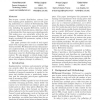Free Online Productivity Tools
i2Speak
i2Symbol
i2OCR
iTex2Img
iWeb2Print
iWeb2Shot
i2Type
iPdf2Split
iPdf2Merge
i2Bopomofo
i2Arabic
i2Style
i2Image
i2PDF
iLatex2Rtf
Sci2ools
CORR
2008
Springer
2008
Springer
Small Is Not Always Beautiful
Peer-to-peer content distribution systems have been enjoying great popularity, and are now gaining momentum as a means of disseminating video streams over the Internet. In many of these protocols, including the popular BitTorrent, content is split into mostly fixed-size pieces, allowing a client to download data from many peers simultaneously. This makes piece size potentially critical for performance. However, previous research efforts have largely overlooked this parameter, opting to focus on others instead. This paper presents the results of real experiments with varying piece sizes on a controlled BitTorrent testbed. We demonstrate that this parameter is indeed critical, as it determines the degree of parallelism in the system, and we investigate optimal piece sizes for distributing small and large content. We also pinpoint a related design tradeoff, and explain how BitTorrent's choice of dividing pieces into subpieces attempts to address it.
| Added | 09 Dec 2010 |
| Updated | 09 Dec 2010 |
| Type | Journal |
| Year | 2008 |
| Where | CORR |
| Authors | Pawel Marciniak, Nikitas Liogkas, Arnaud Legout, Eddie Kohler |
Comments (0)

